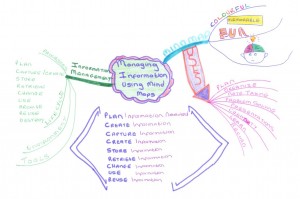Mind maps are a colourful way to organize your thoughts, take notes, and plan activities. Mind maps are also a powerful means of creating, capturing and communicating information. Managing information using mind maps explores how these colourful creations support information management activities.
The core principle of mind mapping is to use colour and images to convey meaning. Mind maps are fun to create and a great way to help organize your ideas and thoughts. Mind maps create a memorable picture of information that is generated by engaging both the left and right sides of the brain, making learning information an engaging task.
Information management involves overseeing the processes of the information life cycle. These processes include, planning the information required, capturing or creating the information, changing the information during its life cycle to keep it up to date, retrieving the information when needed, using the information retrieved, and later archiving, destroying or reusing the information.
Information management is also required to develop the infrastructure that supports the information life cycle processes. The infrastructure includes creating the right environment in which to manage information and providing appropriate tools for use in each stage of the life cycle. Mind mapping is a creative activity that provides a creative environment to capture and create information. Mind mapping is a tool that can be used in a number of information management processes at both individual and organizational levels.
Mind maps can be used for planning information that needs to be collected or created. You do not know what information you need until you have identified the decisions, actions and processes that require information. Mind maps can be used to identify the information that you need to support the tasks and decisions in your life by planning your activities, whether for a specific project or your day ahead, mapping the options and identifying the specific tasks required to carry out your plans.
Mind maps are most powerful in capturing and creating information. Mind maps can be created by either externalizing your tacit knowledge to make it explicit, or by making notes from books, lectures and other resources. Mind maps capture both existing information and create new information as you develop the inter-relationships between the ideas depicted on the mind map. Mind maps create a sounding board with yourself and others to help generate new information and new knowledge through the mapping activities, removing the boundaries that can limit our thinking.
Mind maps provide a simple means of recording information for us to remember or retrieve from maps and use. Some mind mapping software tools include search facilities to help locate specific information in a mind map. However the organization of the mind map, and the choice of colours and images used in it, help to create a unique information indexing system, which can be richer and more personally meaningful than that provided by traditional text-based search engines.
Another powerful information management aspect of mind maps is the volume of information that can be stored in one map. This blog is summarized in Figure 1. Articles, talks and books can be summarized in a single map, providing a simple approach to retrieving information. Mind maps can also be used as a communication tool, providing a means of sharing information with other people. Mind maps communicate both information and the relationships between ideas, whilst at the same time providing the freedom to enable new information relationships to be formed within the map.
Mind maps lack the rigour of formal information management tools but information management requires a range of tools that work in different circumstances. Mind maps are a powerful tool for use in managing information. Take a look at the rich information incorporated into mind maps at:
http://www.mindmapart.com/ and http://www.hongkiat.com/blog/mind-maps/ .
Further Reading: information life cycles are discussed in Chapter 1, tacit and explicit knowledge are discussed in Chapter 14.
Please use the following to reference this blog post in your own work:
Cox, S. A., (2014), ‘Managing Information Using Mind Maps’, 10 October 2014, http://www.managinginformation.org/managing-information-using-mind-maps/, [Date accessed: dd:mm:yy]

